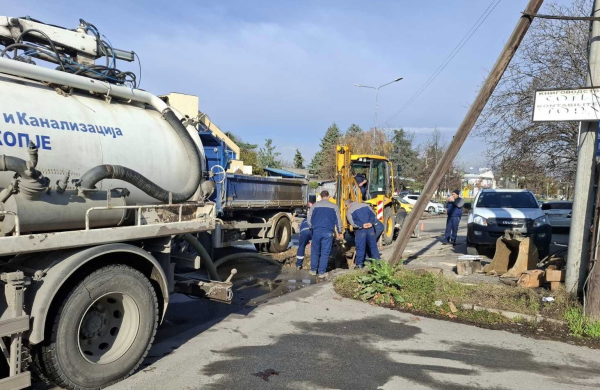All 80 municipalities, plus the City of Skopje, employ 6,271 people in total. 90% of them are under regular employment contracts, whereas 10% are employed under temporary contracts. Tetovo and Makedonski Brod are record-holding municipalities, as the former holds the record in terms of the total number of employees, while the latter is record holder according to per capita number of employees. In the case of small municipalities, like Lozovo and Aracinovo, as much as two-thirds of their respective budgets are spent on salaries.
The number of municipal employees ranges from record-breaking 393 in Tetovo to the minimum of 9 employees in Zrnovci.
The record-breaking number of employees in Municipality of Tetovo does not arise from the record population number. More specifically, with total population of 90,800 citizens, Tetovo has by 36% more employees than the most populated municipality, i.e. Kumanovo, with population of 108,231 citizens.
Second-ranked according to the number of employees is Municipality of Ohrid where in January this year there were 250 people under regular employment contracts and 11 people under temporary employment contracts.
Third-ranked is Kumanovo, with 207 people under regular employment contracts and 43 people under temporary employment contracts.
High on this list is one Skopje-based municipality – Karpos, with 226 employees, of which 129 are under regular employment contracts and 97 were recruited through temporary employment agency. For comparison, Kisela Voda – another Skopje-based municipality with approximately same population number as Karpos – has 155 employees, i.e. by 37% less employees than Karpos. It should be noted that, unlike other bigger municipalities, relevant payrolls of Skopje-based municipalities do not include people employed at firefighting departments because this competence is transferred to the City of Skopje.
Otherwise, the group of municipalities with more than 200 employees and high ranks on this list is completed with Stip (221) and Strumica (212).
The next group of 13 municipalities with employees in the range from 100 to 200 is led by Prilep (185) and Bitola (178).
The most numerous group of municipalities is comprised of those with less than 100 employees, led by Radovis with 92 employees and completed by Zrnovci with only 9 employees. Slightly better ranked than Zrnovci are Zelenikovo and Rosoman, with 11 employees each.
These data are undoubtedly indicative of the lack of clear parameters on the adequate number of municipal employees in terms of total population and municipal competences.
Rankings according to per capita ratio of municipal employees
Differences and disparities among municipalities in terms of the number of employees become more evident with research results related to municipalities’ ranking according to their per capita ratio of employees, i.e. the ratio of municipal employees and total population.
While the Municipality of Makedonski Brod has one employee for every 88 citizens, Municipality of Saraj, which is part of the City of Skopje, has one employee providing services to as many as 1,135 citizens. In comparison, the national average stands at one employee per 385 citizens.
Top 11 positions on this list are occupied by smaller municipalities, with population of less than 8,000 citizens.
They are Makedonski Brod, Staro Nagoricane, Novaci, Lozovo, Rankovci, Gradsko, Sopiste, Pehcevo, Caska, Demir Kapija and Makedonska Kamenica.
Nevertheless, differences and inequality was also observed among them, because not all municipalities with small population number have high per capita number of employees. One group of municipalities with small population number, also have lower per capita number of employees: Demir Hisar, Konce, Karbinci, Mogila, Zrnovci, Centar Zupa, Rosoman and Zelenikovo.
Highest-ranked among bigger municipalities is Ohrid (13th position) where one municipal employee services 202 citizens. Next are Stip, with one employee per 220 citizens, and Tetovo with 213 citizens per employee. Leading five municipalities according to this parameter also include Karpos and Strumica. More specifically, Karpos has one employee per 264 citizens, while in Strumica there are 267 citizens per one municipal employee.
The situation in the seven municipalities at the bottom of the rank list is the worst, as one municipal employee services between 700 and 800 citizens in Aracinovo, Vrapciste, Bogovinje and Studenicani.
At the bottom are Lipkovo with 925 citizens per employee, Suto Orizari with 961 citizens per employee, and Saraj where one municipal employee services more than 1,000 citizens, i.e. 1,135 citizens.
Analysed per regions, the highest employment in this sense among all eight regions in Macedonia was noted among municipalities in the East, which is one of the poorest regions, while municipalities in Skopje, as the richest region, have the lowest employment.
From 9% to 66% of municipal budgets are spent on salaries
In order to obtain clear image about the amount of funds spent by municipalities on salaries and the amount available to fund municipal operation, as well as to improve living and working conditions for the local population, this research analysed the municipalities’ consolidated budgets.
This means that revenue side of municipal budgets included funds received as earmarked grants and central government transfers, revenue from donations, and possible influx of funds from loans. More specifically, many municipalities are able to finance their capital investments, which are certainly important for improving quality of life on local level, due to support from the central government.
On the other hand, salaries paid from the municipal budget, in addition to salaries for municipal administration, also include those paid from municipalities’ consolidated budgets, i.e. salaries for employees in kindergartens, primary and secondary schools, firefighting departments, etc., which are covered by the central government in the form of earmarked grants for municipalities. Actually, this is the only way to obtain the actual image about the amount of funds disposed by the municipalities.
According to data obtained from municipalities, it could be concluded that in 2015 the total amount of consolidated budgets for all 80 municipalities and the City of Skopje is projected at around 674 million EUR, of which 244 million EUR or 36% will be spent on salaries for employees in municipal administration, kindergartens, primary and secondary schools, firefighting departments, etc.
The rank list according to salary costs under the consolidated budgets underlines the great disparities among municipalities.
As many as 30 municipalities spend from 45% to 66% of their respective budgets on salaries and use the remaining funds to finance municipality operation, contribute to costs of education institutions, and invest in roads, sewage networks, parks, new buildings and the like.







